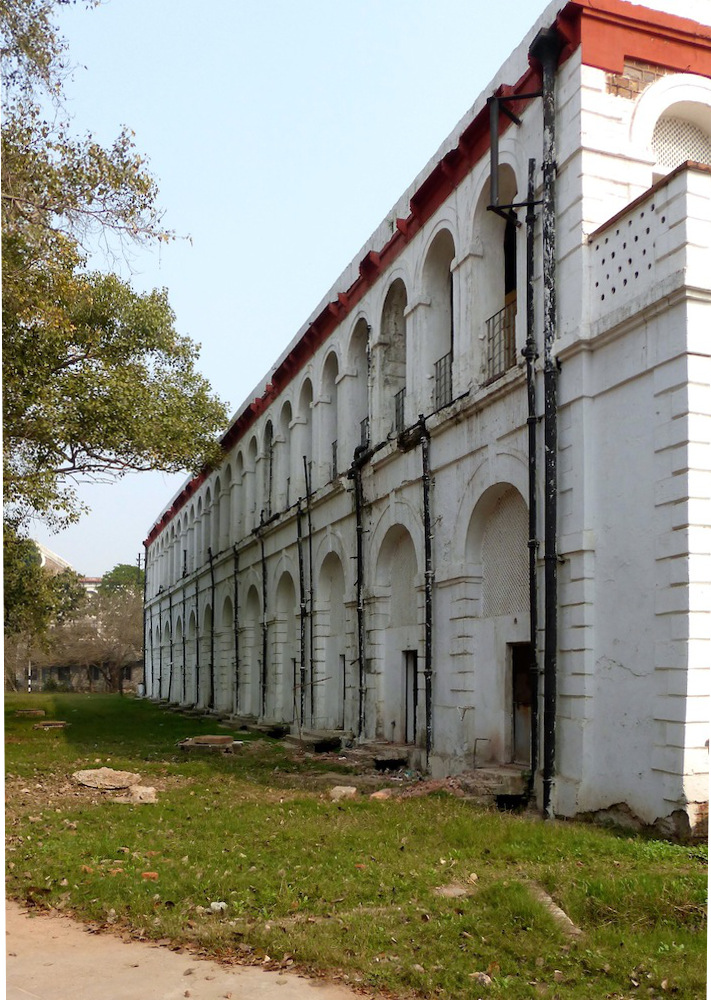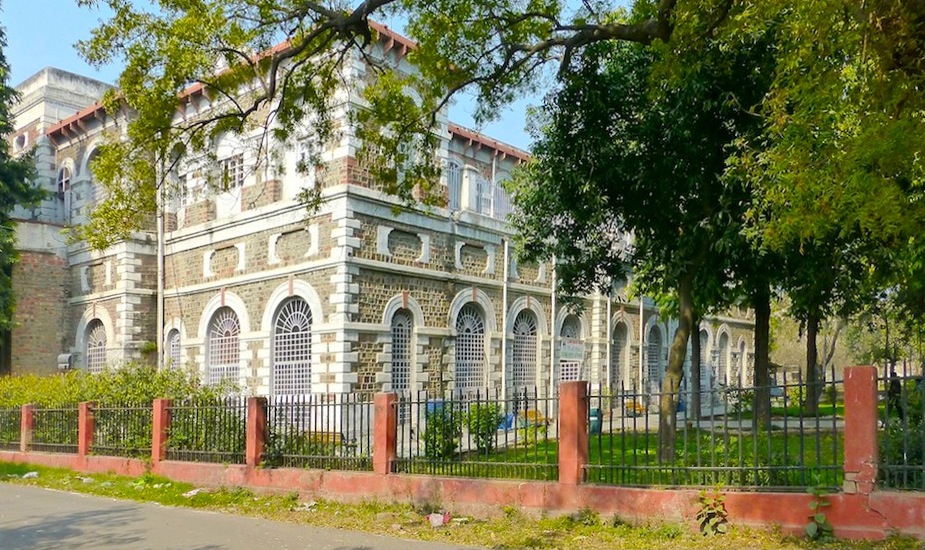Photographs by the author. You may use these images without prior permission for any scholarly or educational purpose as long as you (1) credit the photographer and (2) link your document to this URL in a web document or cite the Victorian Web in a print one. [Click on the images to enlarge them.]

Three-storeyed British army barracks along the west side of the gardens of the Red Fort, Delhi, c. 1858 onwards.
Built from yellow brick with red-brick and stone dressings, timber and steel, there were altogether "13 single-storeyed barracks..., 15 double-storeyed modern structures, 12 brick quarters, 6 bungalows ... and 8 godowns" within the Red Fort complex (Red Fort, 81). They were, of course, markedly different from the original palace's structures, two of which can be seen above: on the far left is the edge of a marble pavilion, and on the right a sandstone one that stands in a great tank, reminding us of a time when water channels coursed through elaborate formal gardens.



Views of a two-storey block to the side of the route from the Lahori Gate. (a) The front of the block. (b) A side view. (c) The plainer rear.
For institutional buildings, these are all quite pleasant: varied and with modest but quite attractive decorative touches, large cooling archways, and a general nod to the orient in other ways too, especially at the end with its outside steps. Yet they have come in for a great deal of vituperative comment. William Dalrymple, for example, calls them,"some of the most crushingly ugly buildings ever thrown up by the British Empire" (222).
The problem is actually not with the buildings themselves, but with what was sacrificed to provide space for them. The nineteenth-century architectural historian James Fergusson, always a man of strong opinions, could hardly contain himself when he wrote about the British desecration of the Red Fort. Dilapidated it may have been, he admits, and there had been insensitive additions. But "all the essential parts of the structure were there." It could easily have been restored to its former glory, he complained:
The idea, however, of doing this was far from entering into the heads of our governors. The whole of the harem courts of the palace were swept off the face of the earth to make way for a hideous British barrack, without those who carried out this fearful piece of Vandalism thinking it even worth while to make a plan of what they were destroying, or preserving any record of the most splendid palace in the world. [209]
Recent critics agree: "Decayed though the state of the Red Fort had been before the Uprising, it was almost destroyed by the changes made by the British" (Peck 241).
These commentators' ire is understandable. Even those "gems of the palace" that were not razed were used for army purposes. One was used as a mess room, for example. And, as Fergusson pointed out, the fact that these "gems" were left "without the courts and corridors connecting them" meant that they lost
all their meaning and more than half their beauty. Being now situated in the middle of a British barrack-yard, they took like precious stones torn from their settings in some exquisite piece of Oriental jeweller's work and set at random in a bed of the commonest plaster. [209]
What upset Fergusson most was the abundance of space that could have been used without such a desecration of the existing buildings, and the spurious argument that the palace walls were needed as defences when the population had been so comprehensively defeated and depleted. He himself suspects that the walls were just to help control soldiers' movements, or from some other base motive: "most discreditable to all concerned" (210n.), he thundered.


Polychromy, quoins, dentils and other features make these buildings much more than simply utilitarian.
Nothing that the army engineers designed and built here could ever have been worthy of such a setting. Nor could it have made up for the losses inflicted on the Red Fort. But these British structures are by no means unprepossessing in themselves. Interestingly, Dalrymple disparages them by saying they look as though they were modelled on the Victorian prison buildings of London's Wormwood Scrubs (222). In fact, the prison blocks were built later, in 1874-91, and since Dalrymple wrote his book have been given Grade II listing for their "innovativeness of design, intrinsic architectural interest and group value"; the prison's striking gatehouse was designated Grade II* ("Wormwood Scrubs"). So the comparison is, in fact, to the barracks' credit.
Related Material
- The Red Fort, Delhi, in Victorian Times
- The Red Fort at Delhi: Walls and Gateways
- The Red Fort at Delhi: Arches and Designs
- "The Epic of the Race": The Indian Uprisings of 1857
References
Dalrymple, William. City of Djinns: A Year in Delhi. London: Harper Perennial, 2005.
Fergusson, James. History of Indian and Eastern Architcture. New York: Dodd, Mead & Co., 1899. Internet Archive. Contributed by the University of Michigan. Web. 22 February 2015.
Peck, Lucy. Delhi: A Thousand Years of Building. New Delhi: Roli (Lotus), 2005.
Red Fort. Based on the text of Y. D. Sharma. Delhi: Archeological Survey of India (Goodearth Publications), 2009.
"Wormwood Scrubs given listed building status." The Telegraph, 9 March 2009.
Last modified 22 February 2015